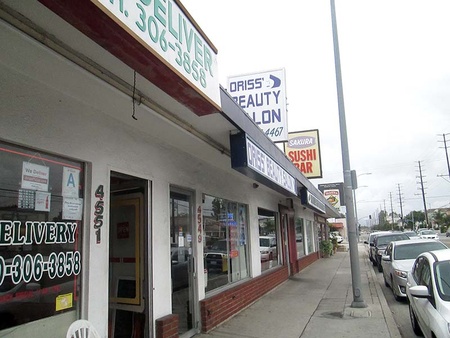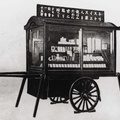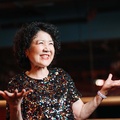Although the Southwest District was once the center of the Japanese community in Los Angeles, the Japanese population plummeted like the tide after the Watts Riots. Venice, which we visited next, has a very different appearance from the Southwest District. This is because the Japanese community is still firmly established, centered around the community center and Honganji temple. It is true that the population has decreased compared to the past, but the unity of Japanese people in this area remains strong. We asked Perry Miyake, who has spent most of his life here since he was born, about the secret behind this.
Japanese Americans returning from internment camps
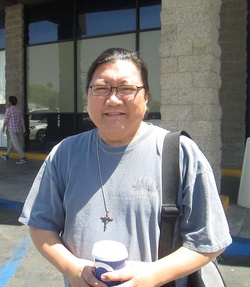
Perry Miyake, a Sansei born and raised in Venice who still works in the area, in front of the Japanese market where he works.
Miyake was the central figure in compiling the book commemorating the 88th anniversary of the Venice Japanese Community Center, published in 2011. He is also an author, having published a novel called "Manzanar in the 21st Century."
In the introduction to the commemorative book, he writes about Venice: "We are not in Venice (as you might imagine it). We are far inland, with no beaches, no boardwalks, no tourists. But we call ourselves the Venice Japanese Community Center because Venice Hongwanji Buddhist Temple and the Venice-Santa Monica Free Methodist Church are at the root of a century of history for the Japanese American community in Venice, California."
Miyake was born in 1953 as a third-generation Japanese. His grandfather on his father's side, originally from Hiroshima, came to the United States in 1901, then returned to Japan and settled here around 1910. The Miyake family, who lived on a farm located north of the current Venice High School, were blessed with 14 children. Perry Miyake's father was the third youngest child. His father was supposed to graduate from the local Venice High School in 1942, but the war broke out and the family was sent to an internment camp. Unable to return to Los Angeles immediately after the war, his grandfather, father and siblings were hired as apple harvesters on a farm in Michigan. They returned to Venice in 1950, three years before Miyake was born.
Why did the Japanese families who had been separated and torn apart from Venice return? It was largely due to the efforts of Reverend Clyde Barnett of the Santa Monica Free Methodist Church. Reverend Barnett took charge of the Japanese Community Center, which had been vacated after the Japanese families were sent to internment camps, and opened the center as temporary accommodation when the Japanese families returned.
"I heard that until they found a place to settle, families with children slept in the center's classrooms, and single people lived in tents on the grounds," Miyake told us, explaining that the Japanese people who had returned to Venice lived together and supported each other under the protection of the pastor.
Eventually, the Japanese settled in the area and made a living as farmers and gardeners. Celery is especially famous as an agricultural product, and when Miyake was a child, the area was covered with vast celery farms. "Freight cars loaded with celery would run along the railroad tracks along Culver Boulevard, heading to the market in downtown."
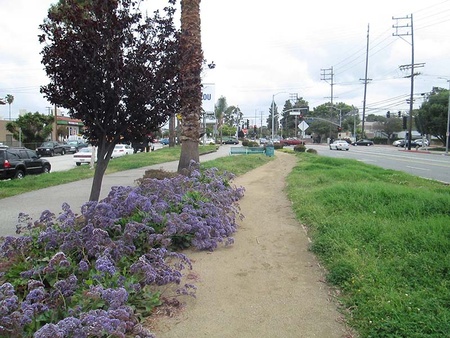
Celery harvested in the area was loaded onto freight trucks and shipped to downtown, where railroad tracks once stood along Culver Boulevard, which has since been converted into a walking path.
The real estate boom has led to people moving to other areas, but festivals and center programs continue to this day
A major change came to Venice's Japanese community in the mid-1970s, when rising land prices caused many Japanese people to leave the area, relocating to the suburbs of the South Bay and Orange County.
Most of the Japanese shops along Centinela, the main street, have been forced to close, leaving only M&S Pharmacy and Sakura Restaurant, which has been bought by a former waitress and continues to operate.
"Within two or three years, there was a real estate boom and prices doubled. All of my Sansei friends left at that time. But many of the Nisei stayed on because it was the place they were used to living in, and my parents still live here."
Miyake himself lived in Long Beach and Hermosa Beach for a few years, but when a rental house two doors down from his parents' house became available, he decided to move back to Venice with ease. He eventually bought the house, and now works in the same Venice neighborhood, in the Japanese market.
"What's attractive about Venice? It's the sense of security that comes from knowing that this is home. My parents and relatives are nearby, and I can still see familiar faces at the community center or church. Not only I, but my mother also enjoys the exercise and nutrition classes for seniors held at the community center. The center offers a variety of classes that can be enjoyed by people of all ages, from children to the elderly. The population has decreased, but they continue to make efforts to attract people. Come to the Obon festival at the temple. It's a very lively event, with Japanese people from all over Venice gathering together."
Miyake's face is beaming with pride as he talks about his hometown, Venice. When I told him that the reason the community activities have continued must be because of the active involvement of people from the third and subsequent generations, like Miyake, he confessed, "The truth is, I only became involved with the community center after I was involved in writing the commemorative book."
© 2013 Keiko Fukuda


